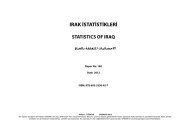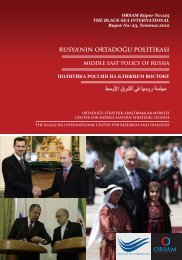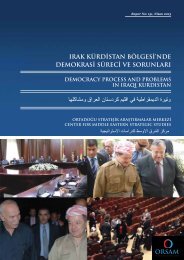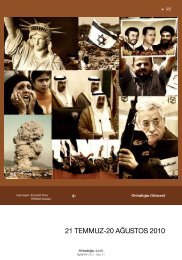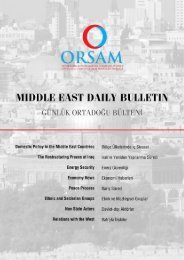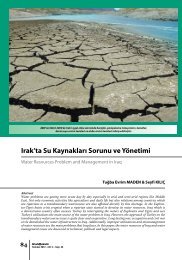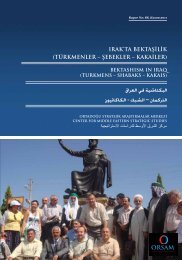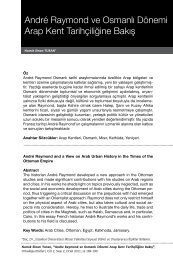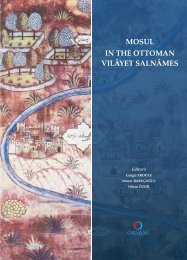turkmen in iraq and their flight - orsam
turkmen in iraq and their flight - orsam
turkmen in iraq and their flight - orsam
You also want an ePaper? Increase the reach of your titles
YUMPU automatically turns print PDFs into web optimized ePapers that Google loves.
TURKMEN IN IRAQ AND THEIR FLIGHT: A DEMOCRAPHIC QUESTION<br />
regular or irregular <strong>in</strong>dividuals or families.<br />
There is also across-level conflict when, for<br />
example, the governments of send<strong>in</strong>g countries<br />
(e.g. the Baath regime <strong>in</strong> Iraq) clash with members<br />
of disadvantaged ethnic groups <strong>in</strong> those<br />
countries (e.g. the Turkmen <strong>in</strong> Iraq). When<br />
the former forces the latter to accept an “Arab”<br />
identity (i.e. the Arabisation policies), the latter<br />
may opt for <strong>in</strong>ternational migration (strategic<br />
option: exit) or may opt to stay <strong>and</strong> accept the<br />
imposed identity (strategic option: status quo).<br />
Households provide examples of mezzo <strong>and</strong><br />
micro level conflict with regards to the <strong>in</strong>fluence<br />
of <strong>in</strong>ternational migration on gender roles.<br />
For example, when husb<strong>and</strong>s move abroad as<br />
“guest workers,” wives often have to take charge<br />
of the households left beh<strong>in</strong>d, which can even<br />
lead to violent conflicts (i.e. domestic violence)<br />
when immigrant husb<strong>and</strong>s return <strong>and</strong> want to<br />
be the head of the household aga<strong>in</strong>. In the Iraqi<br />
case, conflict occurs on multiple levels; there<br />
are policy clashes between the Iraqi government<br />
<strong>and</strong> the governments of countries which<br />
have to accept millions of Iraqis who fled the<br />
country (state level); irregular Iraqi migrants<br />
cross<strong>in</strong>g <strong>in</strong>ternational borders without papers<br />
(multi-level); <strong>and</strong> the power structures with<strong>in</strong><br />
Iraqi households change as males are more likely<br />
to migrate <strong>and</strong> pass power to women left<br />
beh<strong>in</strong>d (household level).<br />
In conflict situations, <strong>in</strong>ternational migration<br />
may appear as a strategic option <strong>in</strong> response to<br />
<strong>in</strong>security. This is what we may call “conflict<strong>in</strong>duced<br />
<strong>in</strong>security” or as formulated <strong>in</strong> general,<br />
an “environment of human <strong>in</strong>security” (EOHI).<br />
Previously I have called it “environment of <strong>in</strong>security”<br />
(EOI); however, with<strong>in</strong> today’s heavily<br />
“securitised” <strong>in</strong>ternational migration discourse<br />
(which has been particularly widespread s<strong>in</strong>ce<br />
the 9/11 attacks), it is necessary to distance this<br />
human security perspective from state security<br />
perspectives <strong>and</strong> move towards human security<br />
where <strong>in</strong>dividual’s needs are the most central<br />
<strong>and</strong> highly- prioritised. As I have discussed<br />
elsewhere, this approach may also refer to the<br />
model of Maslow’s hierarchy of needs model 39 ,<br />
which assigns significance to security among<br />
other needs 40 . Accord<strong>in</strong>g to Maslow, security<br />
needs come after basic needs such as air, food,<br />
shelter, <strong>and</strong> sex, all of which must be satisfied<br />
before higher level needs can be attended to.<br />
The security of home <strong>and</strong> family, community,<br />
neighbourhood <strong>and</strong> country (most likely <strong>in</strong> this<br />
order) will be prioritised by potential migrants.<br />
Of course, the perceived satisfaction of needs is<br />
relative, <strong>and</strong> this should also be taken <strong>in</strong>to account.<br />
But, <strong>in</strong> any case, we can argue that emigration<br />
is one way of satisfy<strong>in</strong>g security needs.<br />
The conflict-<strong>in</strong>duced EOHI has two primary<br />
components. The first is the material environment<br />
of <strong>in</strong>security, which is characterized by<br />
poverty, deprivation <strong>and</strong> armed conflict. The<br />
second is the non-material environment of<br />
<strong>in</strong>security, which is characterized by the fear<br />
of persecution, discrim<strong>in</strong>ation <strong>and</strong> practical<br />
constra<strong>in</strong>ts such as language barriers 41 . People<br />
exposed to the EOHI have two strategic options:<br />
a) status quo <strong>and</strong> b) exit. The exit option<br />
may <strong>in</strong>volve adopt<strong>in</strong>g a rival ethnic identity, defend<strong>in</strong>g<br />
it, jo<strong>in</strong><strong>in</strong>g the rebels, or simply leav<strong>in</strong>g<br />
the conflict area. The status quo option primarily<br />
refers to those who rema<strong>in</strong> <strong>in</strong> the region<br />
<strong>and</strong> adopt the dom<strong>in</strong>ant “ethnic” identity (e.g.<br />
Arabic), adopt<strong>in</strong>g the dom<strong>in</strong>ant “civic” identity<br />
(e.g. Iraqi citizenship), <strong>and</strong>/or align<strong>in</strong>g with government<br />
forces. There can also be mixed strategies.<br />
With<strong>in</strong> this context of ethnic conflict, I identify<br />
a particular type of migrant group which<br />
was dist<strong>in</strong>guished from other migrants by two<br />
key characteristics. Firstly, they were not directly<br />
<strong>in</strong>volved <strong>in</strong> ethnic conflict, <strong>and</strong> secondly,<br />
they were already harbour<strong>in</strong>g a migration plan<br />
which was not related to the ethnic conflict situation<br />
they were on the periphery of which.<br />
They had, however, utilised the context of<br />
EOHI to br<strong>in</strong>g <strong>their</strong> migration plans to fruition.<br />
In consider<strong>in</strong>g this type of migrant it is useful<br />
to refer to Olson’s conception of “free riders”. 42<br />
I found that the EOHI was triggered by the ethnic<br />
conflict <strong>and</strong> served as an opportunity fra-<br />
www.<strong>orsam</strong>.org.tr<br />
19




